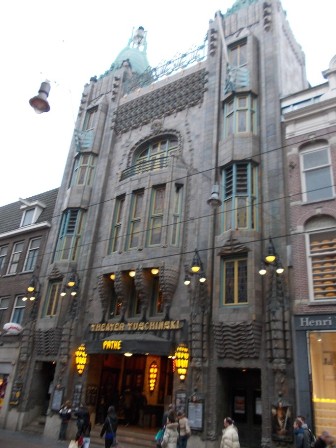Abraham Tuschinski and His Dream
Abraham Icek Tuschinski was only 17 years old when, in 1903, fleeing from a pogrom in his native Poland, he set off for America. He made a brief stop in Rotterdam, awaiting further transport, and then decided to remain there, choosing to pursue his dreams in the Netherlands, which, in his view, was the closest thing to America one could find on the old continent.
At the time, films were a new and widespread passion, and Tuschinski wisely seized this opportunity. By the age of 25, he had already opened his first four cinemas in Rotterdam, and later, in the same city, another one, larger and more beautiful than the rest. The success of these cinemas brought him considerable wealth and granted him a cautious entry into the social class he aspired to join – the refined and educated elite, the upper echelons of society.
Once he was financially ready, Abraham Tuschinski set out to fulfil his greatest dream: to build the most modern and beautiful cinema in the world. He purchased a plot in the heart of Amsterdam, near Rembrandt Square, on Reguliersbreestraat – a location infamously known as Duvelshoek, or the Devil’s Corner.
He commissioned the well-trained but not particularly well-known architect Hijman Louis de Jong, frequently giving him instructions himself and intervening, without hesitation, even in the finest technical details. Thus, from 1918 to 1921, a building was emerging, as a compromise – the result of alternating periods of collaboration and conflict between the seasoned architect and the wealthy cinema magnate. Striving to capture the spirit of the time and the tastes of the audience, they created a structure that today is seen as a controversial fusion of several architectural styles:
- Art Nouveau, a style that had already fallen out of favour,
- Art Deco, a style not yet fully developed,
- Amsterdam School, a style typically used for buildings of a different purpose,
and, most importantly:
- Mr Tuschinski’s personal taste.
Simply put, however, Theatre Tuschinski is best described as an early example of Art Deco architecture – one of the first of its kind in the world.
A Forerunner of Art Deco
In the years following the Great War, architecture began to regain a sense of order. The asymmetrical façades, curved windows, rounded walls, ceramic vines, lizards, and peacocks – those enchanting hallmarks of Art Nouveau – were left behind, as architecture returned to its earthly roots. The dominant trend was moving towards the complete supremacy of function, the elimination of ornamentation, and an emphasis on structure expressed through clear vertical and horizontal lines. This ultimately evolved into the “International Style”, which, in its final form, won the hearts of both the general public and architectural critics alike.
Yet, some who initially embraced these ideas stopped halfway. They sought functionality, clarity, and order, but were reluctant to abandon ornamentation entirely. Façades once again became symmetrical, the structure was generally clear but no longer exposed, and decoration – though more restrained and stylistically simplified – was still present, often confined to a single, designated section of the façade. Instead of the lively motifs of flowers, leaves, vines, reptiles, and birds, highly stylised ones became the norm – sometimes purely geometric, a lingering echo of late Cubism.
If we emphasize the fundamental similarity between Art Nouveau buildings and Alphonse Mucha’s theatrical posters, or between International Style structures and the paintings of Malevich and Mondrian, then Art Deco buildings are the architectural equivalent of Batman comics. Structures built in this style were, at best, simply ignored by the refined, highly aestheticized elite of the time, who saw no reason to grant this approach to architecture any recognition, or even a proper name.
However, what one generation dismisses as kitsch, the next embraces as style. Everything that irritates you about today’s buildings – everything you think you dislike – will, for the next generation, become an authentic architectural movement. They will name it, define its characteristics, analyse its influences, and expound upon it scholarly in their dissertations. Thus, Art Deco was not fully recognized as a legitimate architectural style until the 1960s, when the term itself first appeared – apparently in a British magazine. Today, buildings in the Art Deco style are seen as irresistibly retro, infused with optimism about the future, charming in their naivety, and worthy of cultural preservation.

Theater Tuschinski in Amsterdam, a forerunner of the style, was no exception – its artistic reception followed the entire cycle described above. And it was a painful process. Even during construction, the architect himself could no longer endure the constant aesthetic clashes with the investor. Eventually, after yet another heated argument, architect Hijman Louis de Jong was dismissed from the project. To complete the interior design, two new architects were brought in: Pieter de Besten and Jaap Gidding. When the cinema was completed and its ceramic façade – executed in a style with no clear name – stood unveiled on Reguliersbreestraat, the architectural establishment was unanimous in its verdict: the building was met with harsh, dismissive, and at times even scathing criticism.
Theater Tuschinski
But alas, the public was enthralled…
The entrance foyer was designed and illuminated to transport visitors directly into a world of fantasy. The walls were adorned with rich tapestries, dark exotic woodwork, ceramic and bronze embellishments. A labyrinth of hallways led to several different halls – one housed a cabaret, another was a Japanese tea room, while a third featured a Moroccan interior.
Yet, the true spectacle was the main auditorium. It resembled the ceremonial hall of a European national opera house, with two tiers of balconies and 1,200 seats. An innovative climate control and ventilation system ensured uniform conditions throughout the space. The resonant sound of the theatre organ, crafted by the leading American manufacturer Wurlitzer, filled the space as silent films still dominated the era. In addition, a 16-piece orchestra was permanently employed, and the hall frequently hosted live concerts by some of the world’s most renowned musicians.
During the 1936 renovation, the floor was covered with a luxurious, vibrantly coloured, five-centimetre-thick woollen carpet, woven in Morocco. Half a century later, it was replaced with an identical Moroccan carpet, which remains there to this day.

During the German occupation, the cinema was renamed Tivoli, as Tuschinski was an unmistakably Jewish surname. For the next few years, it screened only German films, prompting Amsterdam’s audience to boycott their beloved Theater and turn instead to the stage, where at least they could watch their own actors and hear their own language.
As a member of the “wrong” people, Abraham Tuschinski was arrested and deported to Poland – the bleak land of his birth, the place he had once tried to escape forever. When he was murdered in Auschwitz on 17 September 1942, his life came full circle in the most nightmarish way imaginable. He had escaped nothing. He had outrun nothing.
Two years later, his best enemy, the architect Hijman Louis de Jong, was also murdered in Auschwitz. His old rival from the battle at the Devil’s Corner, his opponent in the relentless struggle over every artistic detail of the cinema they built together, each trying to shape it into his own masterpiece, neither ever realised that those fiery disputes had been the finest thing life had given them.
After the war, the cinema regained its glory, and today it shines brighter than ever. It remains the venue of choice for all major Dutch film premieres. On such occasions, a red carpet is unfurled across the entrance steps and pavement, leading the world’s biggest film stars towards an even more opulent, ceremonial Moroccan carpet in Amsterdam’s temple of illusions.
Between 1998 and 2002, the theatre underwent a thorough restoration and expansion. It now boasts six screening rooms, yet for the true Tuschinski experience, one must visit the grand auditorium where, in addition to standard seating, guests can enjoy special love seats for couples or private boxes where cheese and wine are served. The Moroccan salon and the Japanese tea room are still there, more exquisite than ever.
And what do the people of Amsterdam – who grow up surrounded by the works of Rembrandt, Vermeer, and Van Gogh – think today of this cinema’s artistic and architectural merits? Well, as we all know, Amsterdam is a city of pragmatic free spirits. Here, soft drugs are tolerated, the women under the “red lanterns” are respected, and people go to their favourite cinema to simply enjoy life.
After all, these days, a ticket to Theater Tuschinski to watch James Bond will cost you more than entry to the Rijksmuseum to see Rembrandt, Vermeer, and Frans Hals combined.
Darko Veselinović, February 2013



